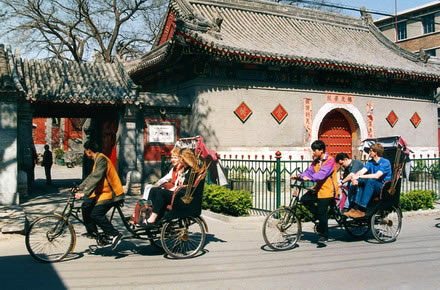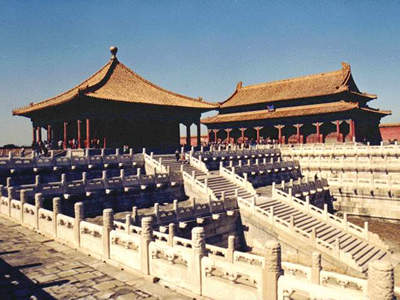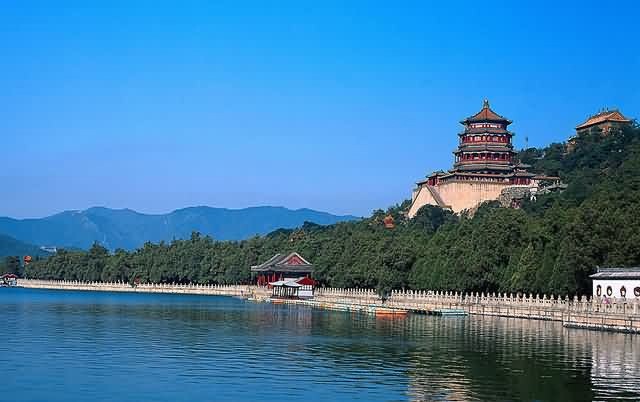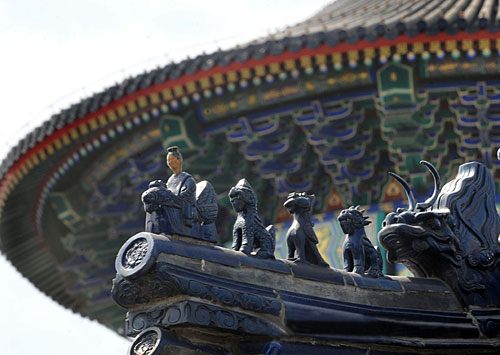 especially in the early morning when limber septuagenarians practice calisthenics.
especially in the early morning when limber septuagenarians practice calisthenics. The Hall for the Prayer of Good Harvests: The Temple of Heaven incorporates several religious structures, the crown jewel of which is the Hall for the Prayer of Good Harvests. The layout of compound reflests its religious purpose and so adheres to geomantic precepts. For instance, the northern end of the park is curved while the southern end is spuare, reflecting the traditional Chinese conception of heaven as round and the earth as spuare. Likewise, the park gates are located at the four cardinal points.
The Circular Altar is the three-tiered structure closest to the southern gate. Built in 1530, the Circular Alatar was where the emperor, facing north, gave heaven his report. It was acoustically designed to help the emperor's words reach the cosmos. Indeed, teh altar magnifies the voice of a speaker standing in its center, though only the speaker will hear this magnification, as sound waves bounce off the balustrades. Another interesting feature of the altar is that it was built with rows of marble slabs in multiples of the number9, which was considered the most auspicious number. The first row has 9 slabs, the second 18, and so on. The construction of the Altar of Heaven was begun in 1530. It was rebuilt once in 1749. Because
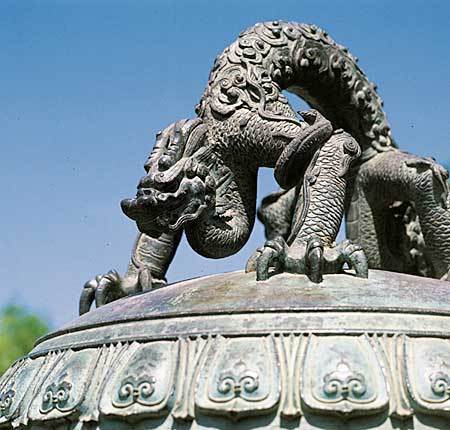 the sacrifices were made to Heaven, it was thought best to leave the structure open to the sky. Because a circle symbolizes Heaven, the platform is round. It is surrounded by two sets of walls; the outer square wall symbolizing Earth and the inner round wall symbolizing Heaven.
the sacrifices were made to Heaven, it was thought best to leave the structure open to the sky. Because a circle symbolizes Heaven, the platform is round. It is surrounded by two sets of walls; the outer square wall symbolizing Earth and the inner round wall symbolizing Heaven. Moving northward, the next compound is the Imperial Vault of Heaven, which contained tablets of the emperor's ancestors that were used in the solstice ceremony. The vault is surrounded by the Echo Wall, which has marvelous acoustic properties. Its curvature acts as a parabola allowing two people to converse in quiet voices at a great distance to converse in quiet voices at a great distance from each other. However, on a crowded day when every visitor attempts this experience, all you may hear is a cacophonous muddle. The desighners of the temple grounds incoroarated numerous unique acooustic properties to the layout of the complex as there are many spots where sounds are amplified, echoed or redirected.
Circle around the outside of the vault after exiting and proceed north through a gate to the elevated walkway. As you walk, the Hall for the Prayer of Good Harvests will rise into view. This is where the emperor prayed to heaven on behalf of his subjects. This wooden tower was erected without a single nail, it's held in place by an imgenious system of supporting beams and massive pillars. The desigh is also rich in symbolism. Topped by a golden orb, its cascading roof is blue, representing the color of heaven. The four central pillars symbolize the months, and the 12 outer pillars symbolize the 12 watches of the day. Inside the hall, on the ceiling, is a single golden dragon representing the emperor. Initially constructed in 1420, the Hall was set ablaze by a bolt of lightening in 1889 and was fithfully rebuilt with lumber imported from Oregon.
Other items of interest in the Temple of Heaven are the bronze incense burner ornamented with the Eight Diagrams and the bronze tripod ( ding ) in front of the Hall of Prayer for a Good Year, the Hall of Imperial Heaven (Huangqiandian), the Divine Kitchen and the Seventy-two Corridors, as well as the gnarled Nine-Dragon Cypress, the intertwined cypress and locust trees, and the Seven Meteorites.


 About Beijing
About Beijing 
